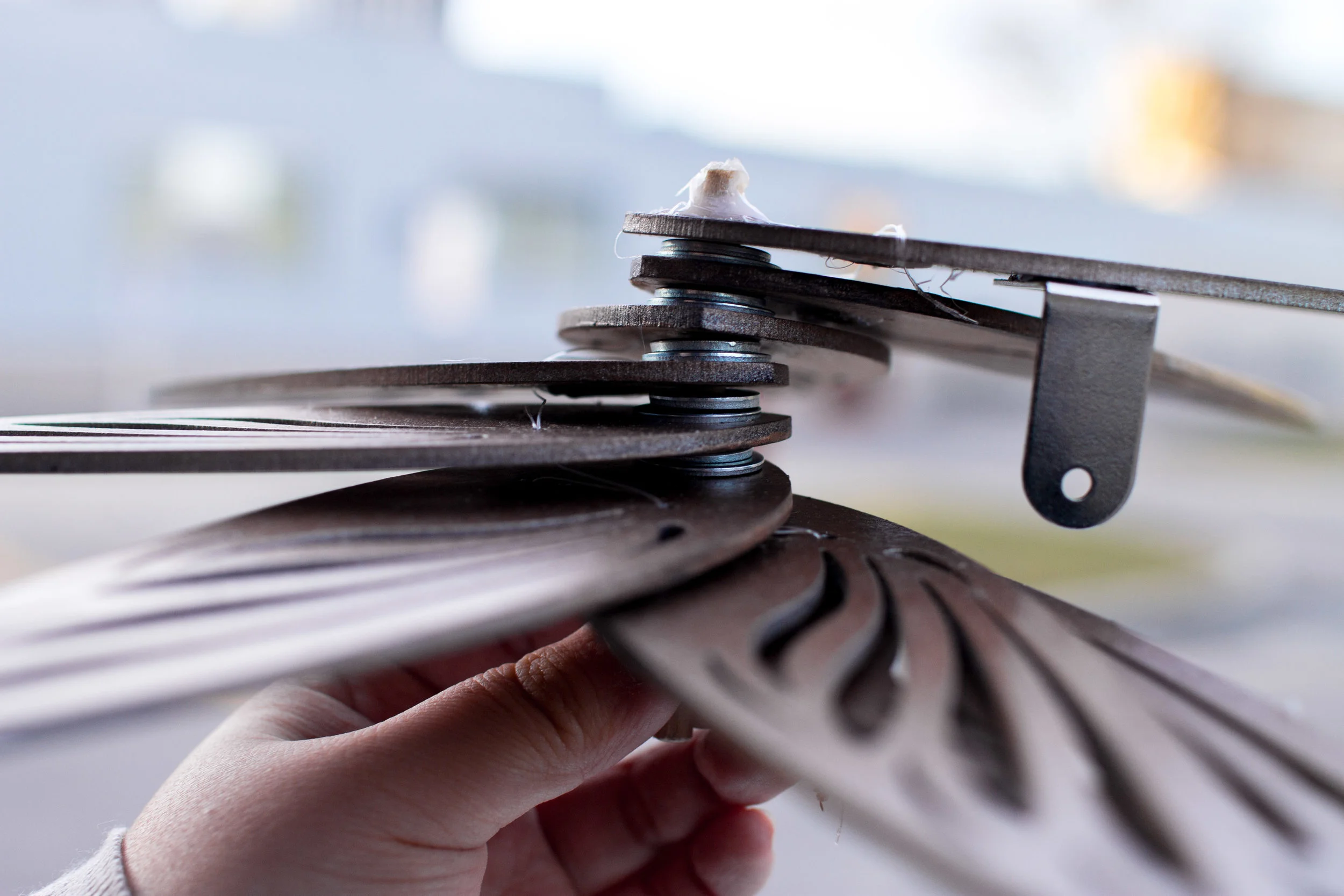Mekanisk Trädgård
Artist Statement
Consisting of a white table held up by four steel pipes, Mekanisk Trädgård is an installation focusing on one aspect of the relationship between people and the natural environment. The tabletop consists of two large, square boards with an open gap between them, showing the circuitry and inner mechanics of the work. Upon the board, overlapping waves of plain and coloured mylar are weaved and shaped to create a textual landscape reminiscent of a garden, enhanced by the presence of multiple moving flowers placed at different depths. The feature of metallic bees in the air over the rest of the tabletop allow for a deeper interpretation of the work.
As all aspects of the environment have been affected by human interaction, nature has been changed (and imitated), becoming mechanical and artificial in the process. This installation allows viewers to observe the honest mechanics and circuitry used to power it, emphasizing the complexity of the work it takes to imitate nature and the subtle complications required to copy what nature creates so easily.
The incorporation of metallic bees hovering over the flowers on the table was used to further implicate the replication of the elements of a garden. This addition acts as an environmental statement of the affect human activity has on nature. This idea came out of news articles about the devastating amount of honeybee deaths across the world. The audience is meant to interact with this piece by touching or making a connection with certain petals on the board – requiring human intervention to explore growth and life through the movements of flowers blooming. The name of our installation, Mekanisk Trädgård, is a playful link back to our aim for minimalistic design, as well as a reference to the increasingly commercialized world around us.
Time Frame
4 weeks
Project Type
Tech Art, Fine Arts, Engineering
CONTRIBUTORS
Jodie Tu, Isaac Hunter, Christie Shen, Beverly Zabawskyj
Materials
Masonite, acrylic, wood, LED lights, steel pipes, Arduino Uno, stepper motors, black wire, fishing wire, mylar
Project Overview
The creation of this project was the second half of my Tech Art class where I worked with two other engineer students and another fine art student. We created this table piece that was powered by two Arduino Uno's which connected to a capacitor sensor that detected the presence of human touch, using the body's natural electrons to activate the sensor. The capacitor sensor triggered the Arduino Uno's to spin three stepper motors which ultimately allowed the flowers to "bloom and blossom" through the opening of the petals that were attached by wooden dowels.
Process
Execution
This installation uses multiple heat sensors to detect human presence in order to activate the mechanics that move on the board and allow the plastic petals to expand on a rig constructed to mimic the blossoming of flowers. This sensor was chosen as it was the quickest to respond when someone puts their hand on the activation pad. There is a delay on each petal for about 5 seconds once the first one is fully expanded so that the audience can focus on one thing at a time.
Takeaway
This project allowed us to work on a larger scale and throughout the process we overcame some obstacles that allowed us to think creatively and problem solve together as a group. The initial idea was to have moving arms that allowed the flowers to slide along the table on axis that were beneath the table, however we realized that the possibility of that action may not be supported by the motors we had. Our plan changed and we made the flowers stationary on the table. Another troubleshooting moment we had was how we were to create a flower mechanism that bloomed once the sensor was activated. We worked through a few models before finally coming to a working structure that allowed the petals to expand one after the other.
Overall, I really enjoyed working with the people in this group to create Mekanisk Trädgård. I learned to be a better problem solver and really think conceptually about how an audience’s interaction with our piece could be so important.

























